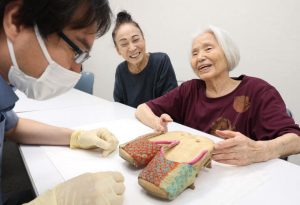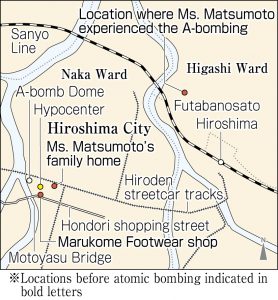Striving to fill voids in Hiroshima—Recreating cityscapes: Geta purchased in former Saiku-machi donated to Hiroshima Peace Memorial Museum
Sep. 7, 2022
Important historical material conveys atmosphere of area right at hypocenter
A-bomb survivor Sachiko Matsumoto donates wooden geta footwear to Peace Memorial Museum for display
by Hiromi Morita, Staff Writer
Earlier this year, on September 6, Sachiko Matsumoto, 97, a resident of the city’s Minami Ward, donated a pair of her wooden geta footwear to the Hiroshima Peace Memorial Museum, located in the city’s centrally located Naka Ward. She had purchased the geta at a footwear shop in the area formerly known as Saiku-machi, above which the atomic bomb later exploded. The geta footwear represents important historical material that communicates a sense of the area and the lives of the people who lived there from the time before the atomic bombing. The museum will add the geta to a special exhibit scheduled to be held this month involving the theme of Saiku-machi and other areas.
The geta are about 23 centimeters in length. The bright pink straps are covered with beautiful dapple-dyed cloth to protect against rain. Her mother bought her the footwear at the Marukome Footwear shop in Saiku-machi after she had graduated from a girls’ high school at the age of around 18. “Marukome” is inscribed on the soles of the geta, and stickers on the backs of the footwear indicate, among other words, “Hiroshima, Saiku-machi.”
Ms. Matsumoto’s family home was in the former Sarugaku-cho, located adjacent to the neighborhood of Saiku-machi. Her parents ran a financing company. She recalls how, “I liked the geta and walked around town wearing them.”
However, that entire area was destroyed in the atomic bombing. Nobody knows what happened to the four members of the family that ran the footwear shop. Ms. Matsumoto had moved to the Futabanosato area (now part of Hiroshima’s Higashi Ward), about 1.7 kilometers from the hypocenter, roughly one year before the end of the war. She survived the atomic bombing but suffered burns on her face and limbs. Her beloved geta were spared the fires generated by the bombing.
After the war, Ms. Matsumoto moved to Hiroshima’s Minami Ward. Her daughter, Etsuko Oka, 73, found the geta lying in the back of a closet she had been tidying up earlier this year, in July.
On September 6, Ms. Matsumoto and Ms. Oka visited the museum and handed over the geta to the museum’s chief curator, Hironobu Ochiba. Ms. Matsumoto said, “If I had been in Sarugaku-cho that day, the geta would not have survived. I hope as many people as possible come to see them.”
(Originally published on September 7, 2022)









